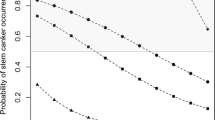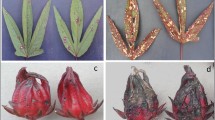Abstract
Banana (Musa spp.) is cultivated throughout Brazil, with genotypes varying from region to region. Yellow Sigatoka disease (Pseudocercospora musae) is one of the most common foliar diseases of banana, causing severe losses when it is not properly managed. The objectives of this study were to evaluate banana genotypes for their reaction to yellow Sigatoka infection, and to perform an epidemiological study of this disease to have a better understanding of how it progresses under the environmental conditions of the Brazilian Cerrado. The reaction of 21 genotypes of banana to the infection by P. musae was evaluated in an experiment at Embrapa Cerrados (Planaltina, DF, Brazil), between August 2009 and January 2011, using a diagrammatic scale adapted from Stover, which ranged from 1 (<1% leaf area showing symptoms) to 6 (> 51% leaf area showing symptoms). Assessments occurred every 15 days. At the end of the evaluation period the mean area under the disease progress curve (AUDPC) for each rated material was calculated. Genotypes were selected by Embrapa Mandioca e Fruticultura Tropical and separated into four sets: Cavendish/Gros Michel, Pome-Pacovan, Pome-Prata-anã and Silk/Mysore. An epidemiological study of the disease progress curve for each genotype was carried out to evaluate which non-flexible model (Monomolecular, Logistic, Exponential or Gompertz) would have the best fit to the disease severity progress curve data. Each set revealed genotypes with significant resistance to Yellow-Sigatoka. In the Pome-Pacovan set, resistance was observed in genotypes ‘Vitória’, ‘PV 94–01’, ‘Pacovan Ken’, ‘Japira ‘and ‘PV 79–34′; in the Silk/Mysore genotypes ‘Caipira’, ‘YB 42–03′, ‘YB 42–07′ and ‘BRS Tropical’; in the Pome-Prata-anã set, genotypes ‘PA 94–01′, ‘BRS Platina’ and ‘BRS Garantida’; and in the Cavendish/Gros Michel set the genotype ‘Bucaneiro’. The monomolecular model displayed the best fit, with consistently low mean square error (MSE) values for all banana genotypes presented in this study.
Similar content being viewed by others
References
Brito, F. S. D., Fraaije, B., & Miller, R. N. G. (2015). Sigatoka disease complex of Banana in Brazil: Management practices and future directions. Outlooks on Pest Management, 26(2), 78–81.
Campbell, C. L. & Madden, L. V. (1990). Introduction to plant disease epidemiology. New York: John Wiley. 532 p.
Cordeiro, Z. J. M., & Matos, A. P. (2005). Expressão da resistência de variedades de banana à sigatoka-amarela. Fitopatologia Brasileira, 30, 532–534.
Daniells, J. W., & Bryde, N. J. (2001). Banana varieties: The ACIAR years 1987–1996. Brisbane, Australia: Queensland Department of Primary Industries.
Del Ponte, E. M., Godoy, C. V., Canteri, M. G., Reis, E. M., & Yang, X. B. (2006). Models and applications for risk assessment and prediction of Asian soybean rust epidemics. Fitopatologia Brasileira, 31, 533–544.
Embrapa. (2012). Cultivo da Bananeira BRS Platina (Sistema de Produção, 20). In Cruz das Almas. Bahia, Brazil: Embrapa Mandioca e Fruticultura.
FAO (2019) FAO statistical databases: agricultural production. http://www.fao.org/faostat/en/#data/QC. Accessed in: 29/03/2019.
Fouré, E. (1994). Leaf spot diseases of banana and plantain caused by Mycosphaerella musicola and M. fijiensis. In Jones, D.R. (Ed.), The improvement and testing of Musa: a global partnership (pp. 37–46). Honduras: International Network for the Improvement of Banana and Plantain (Inibap).
Gasparotto, L., Coelho, A. F. S., Pereira, M. C. N., Pereira, J. C. R., Cordeiro, Z. J. M., & Silva, S. O. (1999). Thap Maeo e Caipira: cultivares de bananeira resistentes à sigatoka-negra, para o estado do Amazonas (Comunicado Técnico, 2). Manaus: Embrapa Amazônia Ocidental.
Gasparotto, L., Pereira, J. C. R., Pereira, M. C. N., Costa, M. M., Cordeiro, Z. J. M., & Silva, S. O. (2001). Prata Ken: cultivar de bananeira resistente à sigatoka-negra, para o estado do Amazonas (Comunicado Técnico,10). Manaus: Embrapa Amazônia Ocidental.
Gasparotto, L., Pereira, J. C. R., Pereira, M. C. N., & Costa, M. M. (2002). FHIA 18: cultivar de bananeira resistente à sigatoka-negra, para o estado do Amazonas (Comunicado Técnico, 12). Manaus: Embrapa Amazônia Ocidental.
Goedert, W. J. (1989). Região dos cerrados: Potencial agrícola e política para seu desenvolvimento. Pesquisa Agropecuária Brasileira, 24(1), 1-17.
IBGE. Levantamento sistemático da produção agrícola (2019). http://biblioteca.ibge.gov.br/index.php/biblioteca-catalogo?view=detalhes&id=766. Acessed in: 29/03/2019.
Jeger, M. J., & Viljanen-Rollinson, S. L. H. (2001). The use of the area under the disease progress curve (AUDPC) to assess quantitative disease resistance in crop cultivars. Theoretical and Applied Genetics, 102, 32–40.
Jesus, O. N., Silva, S. O., Amorim, E. P., Ferreira, C. F., Campos, J. M. S., Silva, G. G., & Figueira, A. (2013). Genetic diversity and population structure of Musa accessions in ex situ conservation. BMC Plant Biology, 13, 41–62.
Ledo, A. S., Martins, C. R., Talamini, V., Silva Junior, J. F., Perito, E. A., & Ledo, C. A. S. (2012). Desempenho de genótipos de bananeira nos tabuleiros costeiros de Nossa Senhora das Dores, Sergipe (Comunicado Técnico, 124). Aracaju: Embrapa Tabuleiros Costeiros.
Madden, L. V., & Hughes, G. (1995). Plant disease incidence: Distributions, heterogeneity and temporal analysis. Annual Review of Phytopathology, 33, 529–564.
Malaquias, J. V., Da Silva, F. A. M., & Evangelista, B. A. (2010). Precipitação pluviométrica em Planaltina, DF: analise de dados da estação principal da Embrapa Cerrados 1974 a 2003 (Boletim de Pesquisa e Desenvolvimento, 299). Brasília: Embrapa Cerrados.
Nwauzoma, A. B., Tenkouano, A., Crouch, J. H., Pillay, M., Vuylsteke, D., & Kalio, L. A. D. (2001). Yield and disease resistance of plantain (Musa spp., AAB group) somaclones in Nigeria. Euphytica, 123, 323–331.
Pereira, J. C. R., Gasparotto, L., Silva, S. O., & Pereira, M. C. N. (2004). BRS Prata Garantida: Cultivar de bananeira resistente à sigatoka-negra (Comunicado Técnico, 25). Manaus: Embrapa Amazônia Ocidental.
Pereira, J. C. R., Gasparotto, L., & Arruda, M. R. (2010). Cultivares. In L. Gasparotto & J. C. R. Pereira (Eds.), A cultura da bananeira na região norte do Brasil (pp. 71–86). Brasília, DF, Brazil: Embrapa Informação Tecnológica.
Peruch, L. A. M., & Sonego, M. (2007). Resistência de genótipos de bananeiras a sigatoka amarela sob cultivo orgânico. Revista Brasileira de Agroecologia, 2(3), 86–93.
Rocha, H. S., Pozza, E. A., Uchôa, C. N., Cordeiro, Z. J. M., Souza, P. E. S., Sussel, A. A. B., & Rezende, C. A. (2012). Temporal progress of yellow Sigatoka and aerobiology of Mycosphaerella musicola spores. Journal of Phytopathology. https://doi.org/10.1111/j.1439-0434.2012.01897.x.
Silva, S. O., Shepherd, K., Dantas, J. L. L., Alves, E. J., Borges, A. L., Fancelli, M., Oliveira, S. L., & Oliveira, M. A. (1996). Avanços do programa de pesquisa em Musa no CNPMF (Documentos, 65). In Cruz das Almas. Bahia, Brazil: Embrapa Mandioca e Fruticultura.
Silva, S. O., Souza Júnior, M. T., Alves, E. J., Silveira, J. R. S., & Lima, M. B. (2001). Banana breeding progam at Embrapa Mandioca e Fruticultura. Crop Breeding and Applied Biotechnology, 1(4), 399–436.
Silva, S. O., Gasparotto, L., Matos, A. P., Cordeiro, Z. J. M., Ferreira, C. F., Ramos, M. M., & Jesus, O. N. (2003). Programa de melhoramento de bananeira no Brasil – resultados recentes (Documentos, 123). In Cruz das Almas. BA, Brazil: Embrapa Mandioca e Fruticultura.
Siviero, A., & Ledo, A. S. (2002). Avaliação de genótipos de banana à sigatoka-amarela na Amazônia Ocidental. Revista Brasileira de Fruticultura, 24(3), 724–726.
Stover, R. H. (1971). A proposed internacional scale for estimating intensity of banana leaf spot. Tropical Agriculture, 48, 185–196.
Trujillo, I., & Garcia, E. (1996). Strategies for obtaining somaclonal variants resistant to yellow Sigatoka (Mycosphaerella musicola). Infomusa, 5, 12–13.
USDA (Natural Resources Conservation Service) (2014). Oxisols. In Soil Survey Staff (Eds.), Keys to soil taxonomy (pp. 257–271). USA: USDA.
Author information
Authors and Affiliations
Corresponding author
Ethics declarations
Conflict of interest
The authors declare that they have no conflict of interest.
Additional information
Publisher’s note
Springer Nature remains neutral with regard to jurisdictional claims in published maps and institutional affiliations.
Electronic supplementary material
Online Resource 1
(XLSX 26 kb)
Online Resource 2
(XLSX 412 kb)
Rights and permissions
About this article
Cite this article
de Campos Dianese, A., Guimarães, T.G., Kreling, A.C. et al. Reaction of Banana (Musa spp. L.) genotypes to yellow Sigatoka (Pseudocercospora musae (Zimm.) on Brazil’s central plateau and an epidemiological study of the disease Progress curves comparing four non-flexible models. Phytoparasitica 48, 107–115 (2020). https://doi.org/10.1007/s12600-019-00774-7
Received:
Accepted:
Published:
Issue Date:
DOI: https://doi.org/10.1007/s12600-019-00774-7




